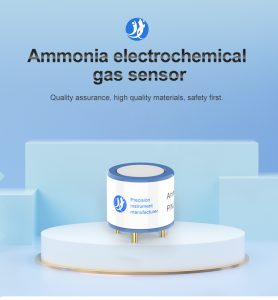Summary:
Due to the characteristics of ammonia, fixed ammonia alarm or portable gas detector should be installed in places where ammonia is easy to leak in the work or living field to detect ammonia leakage and prevent dangerous accidents caused by excessive leakage. At present, there are three major categories for industrial NH3 gas sensors: optical ammonia sensor, metal oxide sensors, conductive polymer ammonia sensors.
First, optical NH3 gas sensor:
The main types of optical sensors are optical interference sensor, ultraviolet absorption sensor, infrared absorption sensor and optical fiber sensor. There are two main optical principles for ammonia detection: one is based on the color of the reagent that reacts with ammonia or the color change of the initiator; Another mechanism is to detect the absorption of light by a gas to determine its concentration.
The gas to be measured can be analyzed by spectrophotometry after the reaction and coloring. Because ammonia gas is alkaline gas, pH test paper can change color under a certain concentration, so as to analyze whether ammonia gas is contained in the atmosphere. However, this test needs to ensure a high concentration of ammonia gas and can not be sensitive to the color change of test paper, which will produce large errors.
Optical sensor can be used to detect the content of ammonia in the environment. It is a kind of gas sensor with high sensitivity and good selectivity. Laser and spectrograph are the main components of optical absorption ammonia detection system. The laser emits light through the air, and the light reaching the detector will have certain influence on the spectrum of different gas components in the air and the characteristics of each component, so as to complete the detection of ammonia content in the gas environment, which has obvious advantages in sensitivity and selectivity.
Two, metal oxide sensor:
Metal oxide gas sensor has become one of the more concerned gas sensitive materials. It is found that tin oxide, molybdenum trioxide and titanium oxide can be used to detect ammonia gas. Metal oxide sensor is a promising gas sensor because of its robustness, low cost and simple operation.
The mechanism of metal oxide sensor is mainly to adsorb ammonia molecules to the sensor layer of metal oxide through chemical adsorption, causing the change of conductance on the metal oxide sensor, so as to determine the concentration of ammonia.
Three, conductive polymer NH3 gas sensor:
Ammonia can be monitored by conducting polymers, such as polypyrrole, polyaniline and polythiophene, which work at room temperature as conductive sensors compared to metals and metal oxides. The sensing mechanism of conductive polymer to ammonia mainly depends on the REDOX reaction between ammonia and conductive polymer. Due to the irreversibility of this reaction, the sensitivity of conductive polymer sensor gradually decreases when exposed to ammonia for a long time.

The three working mechanisms of NH3 gas sensor are optical monitoring, metal oxide monitoring and conductive polymer monitoring. The monitoring methods of ammonia gas are summarized and summarized. Due to the increasing awareness of environmental protection, miniaturization of ammonia gas monitoring sensor is still a trend of gas detection in the future. In addition to ensuring miniaturization of devices, it is necessary to ensure that the sensor has the characteristics of low cost, simple operation, high sensitivity and strong selectivity.
 : +86 155 8830 2704
: +86 155 8830 2704 : jxdziot@gmail.com
: jxdziot@gmail.com
